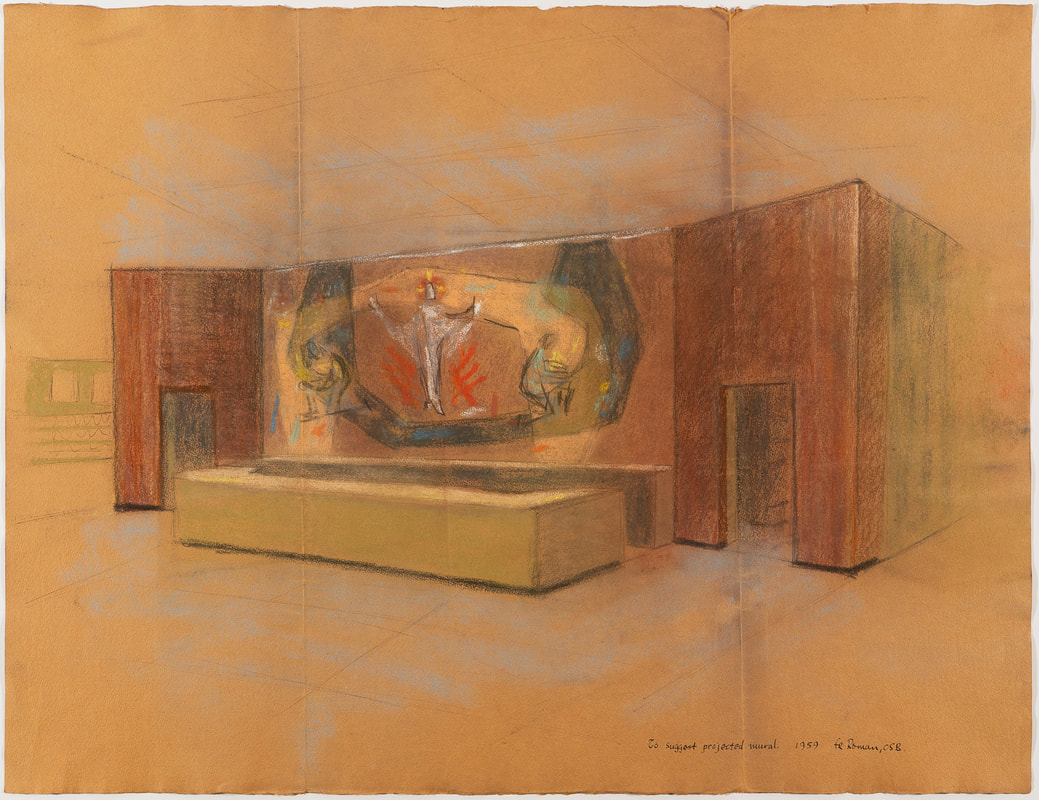If your life’s pursuits are guided with a loving care for the welfare of others, the preservation of nature and the health of other life, then your life’s work has found the Way the Truth and the Life (John 14:6).
During his time as a member of the Saint Vincent monastic community, Verostko was responsible for several monumental projects on campus including a mural at the center of the campus library. Verostko notes:
"...my depiction of the glorified Jesus appears to have his feet, as it were, in two worlds – an early Byzantine world with eyes fixed on a heavenly place and the mid-20th Century world, surrounded by imagery indicative of new directions in the arts and sciences. This fusion of Byzantine and modern styles represents endeavors in all disciplines informed both by tradition and innovation.
"...my depiction of the glorified Jesus appears to have his feet, as it were, in two worlds – an early Byzantine world with eyes fixed on a heavenly place and the mid-20th Century world, surrounded by imagery indicative of new directions in the arts and sciences. This fusion of Byzantine and modern styles represents endeavors in all disciplines informed both by tradition and innovation.
Roman Verostko, Sketch for Suggested Mural, 1959, pastel on paper, 16 x 20, Saint Vincent College Collection.
It was my desire to utilize symbols to represent the pioneering efforts made within the arts and sciences following World War II. This period saw the first commercial computers, the birth of broadcast television and the exploration of space along with advances in medicine, mathematics, chemistry, biology and ecology.
Presented as a modern manifestation, the mural symbolizes these endeavors as enlightened when they are bathed in the light of the core teaching of Jesus that we “love one another.” This symbolism points to our moral responsibility in developing advanced technologies. The development and use of the atomic bomb during World War II raised disturbing questions for many in my generation.
Presented as a modern manifestation, the mural symbolizes these endeavors as enlightened when they are bathed in the light of the core teaching of Jesus that we “love one another.” This symbolism points to our moral responsibility in developing advanced technologies. The development and use of the atomic bomb during World War II raised disturbing questions for many in my generation.
Roman Verostko, American, Born 1929, I am the Way, the Truth and the Life, 1958–1960, ceramic tile, 264 x 132 in., Saint Vincent College Collection, Gift of Mr. and Mrs. Leo N. Hierholzer.
A golden light passes from the haloed head of Jesus and extends down on either side of the wall illuminating symbols of the arts and sciences and two human figures while another large dark form courses through the mural from behind. The figure on the left, turned away from Jesus, is pictured shrouded in a dark shadow examining a bread-like substance symbolizing the holder’s pursuits. The figure on the right, bathed with light, is represented heeding Jesus’ teaching. The substance in the figure’s hand, marked with a cross, symbolizes endeavors guided by concern for the underserved, respecting other forms of life, speaking truth, and care for the earth, humanity’s common home. It is this figure who has found The Way."
Roman Verostko, Study for I Am the Way, the Truth, and the Life, 1958, oil on board, Saint Vincent College Collection. In preparation for the final mural, Verostko created a scale version that laid out his design.
This project received support from many in the Saint Vincent community. Especially notable were Mr. and Mrs. Hierholzer who contributed funds for the materials; Fr. Fintan Shoniker, O.S.B., Director of the Library, whose vision and support made it possible; Fr. Emeric Pfeister, O.S.B., Director of the Art Department who assisted in firing
the tiles, Fr. Campion Gavaler, O.S.B., who suggested the theme based on John 16:4; and Fr. René Gracida, O.S.B., an architect who engineered plans for a welded aluminum frame to cradle the tile in a single stable unit.
the tiles, Fr. Campion Gavaler, O.S.B., who suggested the theme based on John 16:4; and Fr. René Gracida, O.S.B., an architect who engineered plans for a welded aluminum frame to cradle the tile in a single stable unit.



